LULC Change Effects on Environmental Quality and Ecosystem Services Using EO Data in Two Rural River Basins in Thrace, Greece
Abstract
1. Introduction
2. Materials and Methods
2.1. Study Area
2.2. Earth Observation Data and Preprocessing
2.3. Methodology
2.3.1. Multi-Temporal Ecosystem Types Classification
2.3.2. Landscape Pattern Analysis
2.3.3. Eco-Environmental Quality Assessment
2.3.4. Ecosystem Services Assessment
2.3.5. Ecosystem Services Valuation
2.3.6. Sensitivity Analysis of Ecosystem Services Values
2.3.7. Spatial Distribution of Ecosystem Services Values in Relation to LULC
3. Results
3.1. Landscape Changes
3.2. Ecosystem Services Change
3.2.1. Lissos River Basin
3.2.2. Laspias River Basin
3.3. Ecosystem Functions Valuation Change
3.3.1. Lissos River Basin
3.3.2. Laspias River Basin
3.4. Sensitivity Analysis of Ecosystem Services Values
3.5. Spatial Distribution of Ecosystem Services Values in Relation to LULC
4. Discussion
5. Conclusions
Author Contributions
Funding
Data Availability Statement
Acknowledgments
Conflicts of Interest
Appendix A
| ESVf (Million USD) | Overall Change | |||||
|---|---|---|---|---|---|---|
| Ecosystem Services Categories | Ecosystem Functions | 1984 | 2004 | 2021 | Value | (%) |
| Provisioning | Food production | 43.32 | 41.72 | 37.01 | −6.32 | −14.58 |
| Raw materials | 12.08 | 12.44 | 13.08 | 1.00 | 8.28 | |
| Water supply | 3.81 | 3.45 | 3.32 | −0.49 | −12.90 | |
| Regulating and Supporting | Gas regulation | 0.00 | 0.00 | 0.00 | 0.00 | 0.00 |
| Climate regulation | 2.67 | 2.44 | 2.48 | −0.18 | −6.88 | |
| Disturbance regulation | 2.00 | 1.12 | 1.01 | −0.99 | −49.49 | |
| Water regulation | 4.18 | 2.33 | 2.11 | −2.07 | −49.49 | |
| Biological control | 1.66 | 1.30 | 1.58 | −0.08 | −4.92 | |
| Waste treatment | 4.80 | 3.69 | 3.24 | −1.56 | −32.42 | |
| Nutrient cycling | 1.66 | 1.07 | 1.13 | −0.53 | −31.79 | |
| Habitat/refugia | 70.65 | 74.78 | 79.56 | 8.91 | 12.61 | |
| Pollination | 1.70 | 1.81 | 1.93 | 0.23 | 13.46 | |
| Cultural | Recreation | 7.83 | 6.74 | 7.78 | −0.04 | −0.55 |
| Cultural | 5.96 | 5.51 | 4.75 | −1.21 | −20.31 | |
| Total | 162.32 | 158.40 | 158.98 | |||
| ESVf (Million USD) | Overall Change | |||||
|---|---|---|---|---|---|---|
| Ecosystem Services Categories | Ecosystem Functions | 1984 | 2004 | 2021 | Value | (%) |
| Provisioning | Food production | 5.14 | 4.91 | 6.47 | 1.33 | 25.80 |
| Raw materials | 0.46 | 0.43 | 0.67 | 0.21 | 45.18 | |
| Water supply | 0.47 | 0.36 | 0.49 | 0.02 | 3.58 | |
| Regulating and Supporting | Gas regulation | 0.00 | 0.00 | 0.00 | 0.00 | 0.00 |
| Climate regulation | 0.26 | 0.22 | 0.35 | 0.09 | 35.99 | |
| Disturbance regulation | 0.36 | 0.15 | 0.27 | −0.09 | −25.22 | |
| Water regulation | 0.75 | 0.31 | 0.56 | −0.19 | −25.22 | |
| Biological control | 0.16 | 0.09 | 0.23 | 0.07 | 43.89 | |
| Waste treatment | 0.73 | 0.47 | 0.69 | −0.03 | −4.74 | |
| Nutrient cycling | 0.24 | 0.11 | 0.22 | −0.02 | −7.10 | |
| Habitat/refugia | 1.38 | 1.34 | 2.03 | 0.65 | 47.01 | |
| Pollination | 0.03 | 0.03 | 0.05 | 0.02 | 57.25 | |
| Cultural | Recreation | 0.72 | 0.47 | 0.97 | 0.25 | 34.68 |
| Cultural | 0.79 | 0.71 | 0.93 | 0.14 | 18.33 | |
| Total | 11.50 | 9.61 | 13.94 | |||
Appendix B

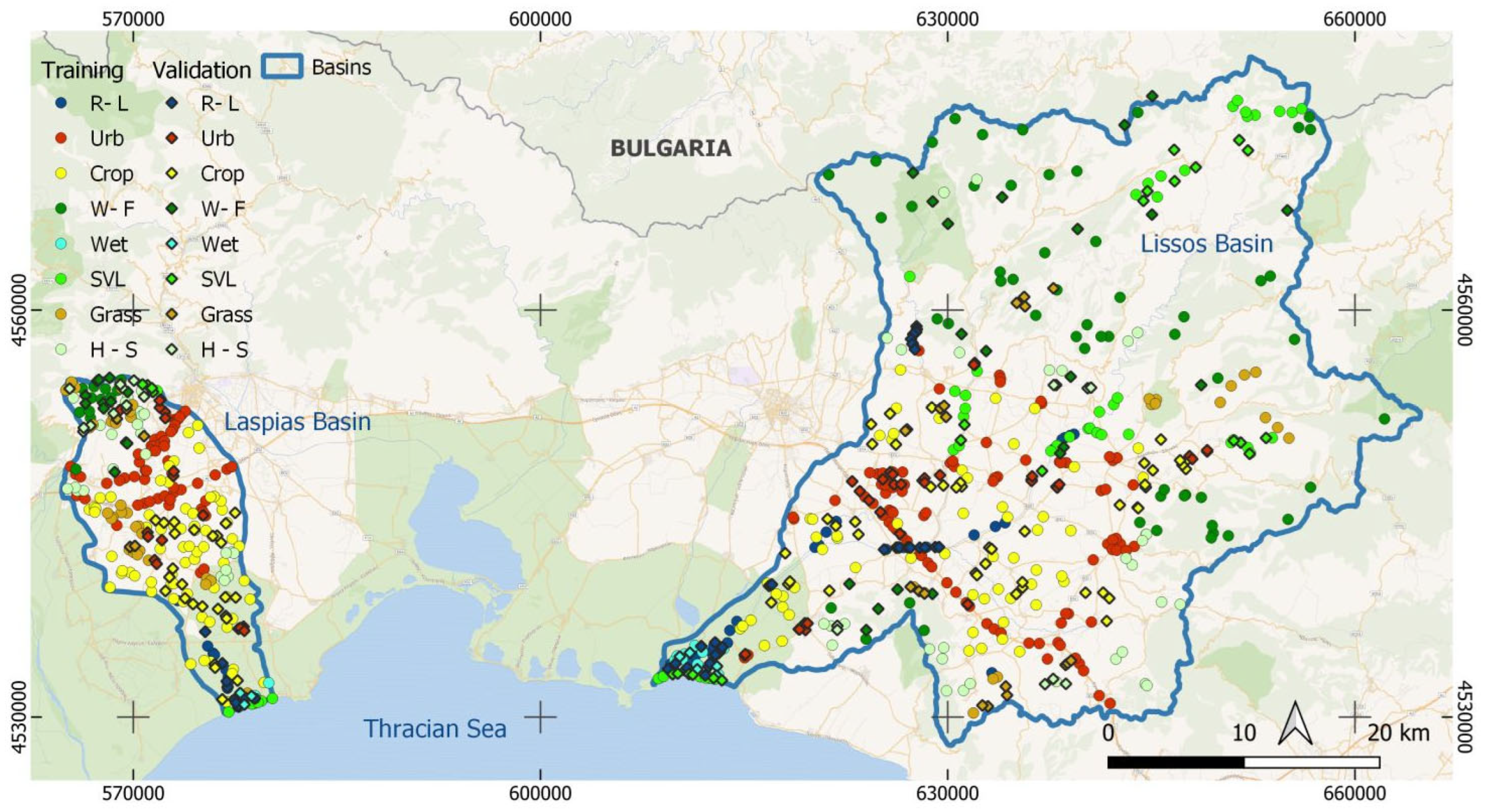
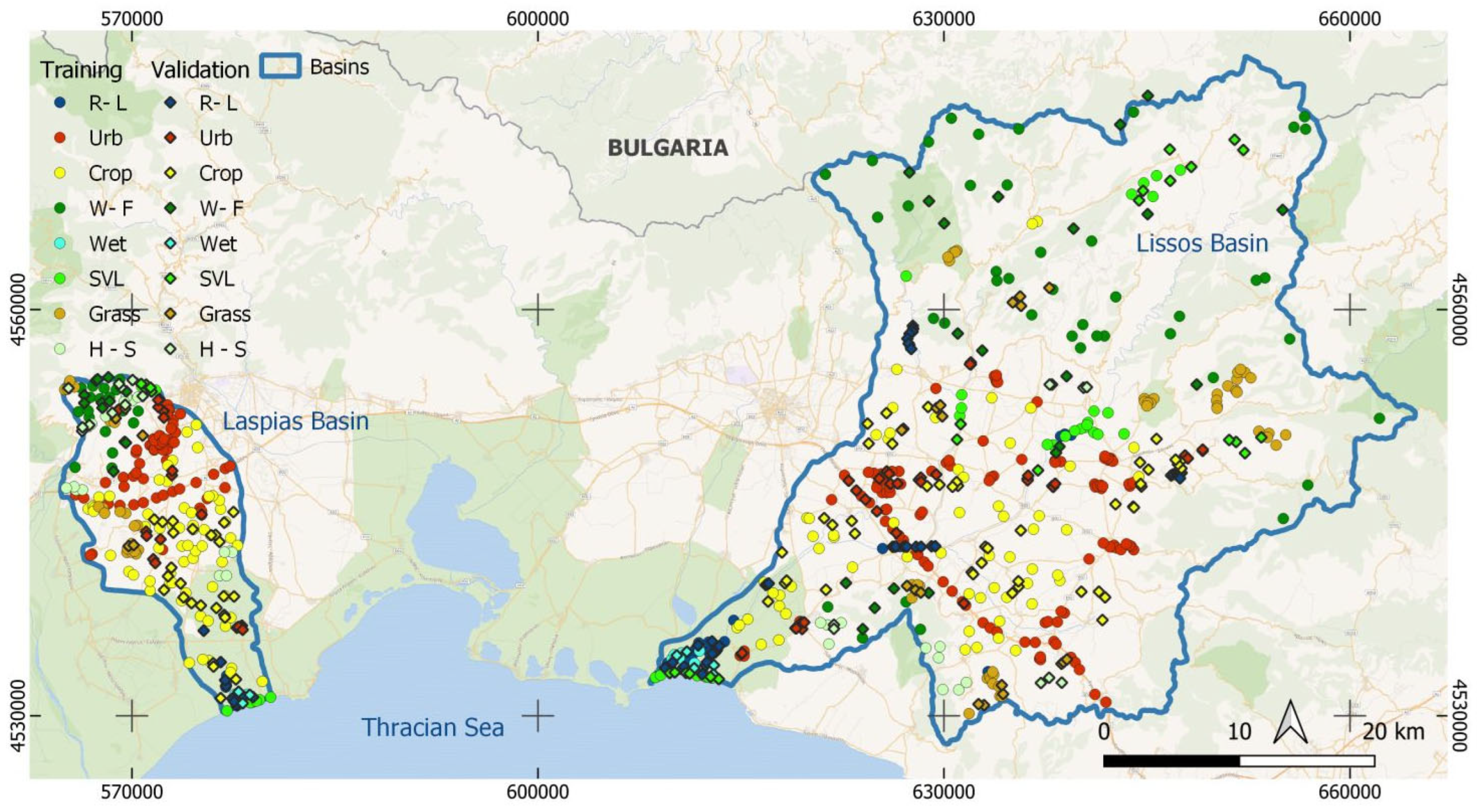
References
- Chen, W.; Chi, G.; Li, J. The Spatial Association of Ecosystem Services with Land Use and Land Cover Change at the County Level in China, 1995–2015. Sci. Total Environ. 2019, 669, 459–470. [Google Scholar] [CrossRef] [PubMed]
- Pan, Z.; He, J.; Liu, D.; Wang, J. Predicting the Joint Effects of Future Climate and Land Use Change on Ecosystem Health in the Middle Reaches of the Yangtze River Economic Belt, China. Appl. Geogr. 2020, 124, 102293. [Google Scholar] [CrossRef]
- Wang, Y.; Dai, E.; Yin, L.; Ma, L. Land Use/Land Cover Change and the Effects on Ecosystem Services in the Hengduan Mountain Region, China. Ecosyst. Serv. 2018, 34, 55–67. [Google Scholar] [CrossRef]
- Sieber, I.M.; Campagne, C.S.; Villien, C.; Burkhard, B. Mapping and Assessing Ecosystems and Their Services: A Comparative Approach to Ecosystem Service Supply in Suriname and French Guiana. Ecosyst. People 2021, 17, 148–164. [Google Scholar] [CrossRef]
- Latinopoulos, D.; Koulouri, M.; Kagalou, I. How Historical Land Use/Land Cover Changes Affected Ecosystem Services in Lake Pamvotis, Greece. Hum. Ecol. Risk Assess. Int. J. 2021, 27, 1472–1491. [Google Scholar] [CrossRef]
- Arowolo, A.O.; Deng, X.; Olatunji, O.A.; Obayelu, A.E. Assessing Changes in the Value of Ecosystem Services in Response to Land-Use/Land-Cover Dynamics in Nigeria. Sci. Total Environ. 2018, 636, 597–609. [Google Scholar] [CrossRef]
- Maes, J.; Teller, A.; Erhard, M.; Condé, S.; Vallecillo, S.; Barredo, J.I.; Paracchini, M.L.; Abdul Malak, D.; Trombetti, M.; Vigiak, O. Mapping and Assessment of Ecosystems and Their Services: An EU Wide Ecosystem Assessment in Support of the EU Biodiversity Strategy; Publications Office of the European Union: Luxembourg, 2020; ISBN 978-92-76-17833-0. [Google Scholar]
- Costanza, R.; d’Arge, R.; de Groot, R.; Farber, S.; Grasso, M.; Hannon, B.; Limburg, K.; Naeem, S.; O’Neill, R.V.; Paruelo, J.; et al. The Value of the World’s Ecosystem Services and Natural Capital. Nature 1997, 387, 253–260. [Google Scholar] [CrossRef]
- Kubiszewski, I.; Muthee, K.; Rasheed, A.T.; Costanza, R.; Suzuki, M.; Noel, S.; Schauer, M. The Costs of Increasing Precision for Ecosystem Services Valuation Studies. Ecol. Indic. 2022, 135, 108551. [Google Scholar] [CrossRef]
- Burkhard, B.; Kroll, F.; Nedkov, S.; Müller, F. Mapping Ecosystem Service Supply, Demand and Budgets. Ecol. Indic. 2012, 21, 17–29. [Google Scholar] [CrossRef]
- Burkhard, B.; Maes, J. Mapping Ecosystem Services; Pensoft Publishers: Sofia, Bulgaria, 2017; ISBN 978-954-642-829-5. [Google Scholar]
- Burkhard, B.; Santos-Martin, F.; Nedkov, S.; Maes, J. An Operational Framework for Integrated Mapping and Assessment of Ecosystems and Their Services (MAES). One Ecosyst. 2018, 3, e24490. [Google Scholar] [CrossRef]
- Hesselbarth, M.H.K.; Sciaini, M.; With, K.A.; Wiegand, K.; Nowosad, J. Landscapemetrics: An Open-Source R Tool to Calculate Landscape Metrics. Ecography 2019, 42, 1648–1657. [Google Scholar] [CrossRef]
- Shetty, S. Analysis of Machine Learning Classifiers for LULC Classification on Google Earth Engine. MSc. Thesis, University of Twente, Enschede, The Netherlands, 2019. [Google Scholar]
- Yang, X.; Meng, F.; Fu, P.; Zhang, Y.; Liu, Y. Spatiotemporal Change and Driving Factors of the Eco-Environment Quality in the Yangtze River Basin from 2001 to 2019. Ecol. Indic. 2021, 131, 108–214. [Google Scholar] [CrossRef]
- Shiliang, S.; Delong, L.; Yi’na, H.; Rui, X.; Zhang, Y. Spatially Non-Stationary Response of Ecosystem Service Value Changes to Urbanization in Shanghai, China. Ecol. Indic. 2014, 45, 332–339. [Google Scholar] [CrossRef]
- Hansen, M.H.; Li, H.; Svarverud, R. Ecological Civilization: Interpreting the Chinese Past, Projecting the Global Future. Glob. Environ. Change 2018, 53, 195–203. [Google Scholar] [CrossRef]
- Wade, A.J.; Skeffington, R.A.; Couture, R.-M.; Erlandsson Lampa, M.; Groot, S.; Halliday, S.J.; Harezlak, V.; Hejzlar, J.; Jackson-Blake, L.A.; Lepistö, A.; et al. Land Use Change to Reduce Freshwater Nitrogen and Phosphorus Will Be Effective Even with Projected Climate Change. Water 2022, 14, 829. [Google Scholar] [CrossRef]
- Costanza, R.; de Groot, R.; Braat, L.; Kubiszewski, I.; Fioramonti, L.; Sutton, P.; Farber, S.; Grasso, M. Twenty Years of Ecosystem Services: How Far Have We Come and How Far Do We Still Need to Go? Ecosyst. Serv. 2017, 28, 1–16. [Google Scholar] [CrossRef]
- Edens, B.; Maes, J.; Hein, L.; Obst, C.; Siikamaki, J.; Schenau, S.; Javorsek, M.; Chow, J.; Chan, J.Y.; Steurer, A.; et al. Establishing the SEEA Ecosystem Accounting as a Global Standard. Ecosyst. Serv. 2022, 54, 101413. [Google Scholar] [CrossRef]
- de Groot, R.; Brander, L.; van der Ploeg, S.; Costanza, R.; Bernard, F.; Braat, L.; Christie, M.; Crossman, N.; Ghermandi, A.; Hein, L.; et al. Global Estimates of the Value of Ecosystems and Their Services in Monetary Units. Ecosyst. Serv. 2012, 1, 50–61. [Google Scholar] [CrossRef]
- Gorelick, N.; Hancher, M.; Dixon, M.; Ilyushchenko, S.; Thau, D.; Moore, R. Google Earth Engine: Planetary-Scale Geospatial Analysis for Everyone. Remote Sens. Environ. 2017, 202, 18–27. [Google Scholar] [CrossRef]
- Vermote, E.; Justice, C.; Claverie, M.; Franch, B. Preliminary Analysis of the Performance of the Landsat 8/OLI Land Surface Reflectance Product. Remote Sens. Environ. 2016, 185, 46–56. [Google Scholar] [CrossRef]
- Ermida, S.L.; Soares, P.; Mantas, V.; Göttsche, F.M.; Trigo, I.F. Google Earth Engine Open-Source Code for Land Surface Temperature Estimation from the Landsat Series. Remote Sens. 2020, 12, 1471. [Google Scholar] [CrossRef]
- Belgiu, M.; Drăguţ, L. Random Forest in Remote Sensing: A Review of Applications and Future Directions. ISPRS J. Photogramm. Remote Sens. 2016, 114, 24–31. [Google Scholar] [CrossRef]
- Ghimire, B.; Rogan, J.; Galiano, V.R.; Panday, P.; Neeti, N. An Evaluation of Bagging, Boosting, and Random Forests for Land-Cover Classification in Cape Cod, Massachusetts, USA. GI Sci. Remote Sens. 2012, 49, 623–643. [Google Scholar] [CrossRef]
- European Environment Agency. Corine Land Cover (CLC) 2018 Version 2020; European Environment Agency: Copenhagen, Denmark, 2018. [Google Scholar]
- Tucker, C.J. Red and Photographic Infrared Linear Combinations for Monitoring Vegetation. Remote Sens. Environ. 1979, 8, 127–150. [Google Scholar] [CrossRef]
- Gao, B. NDWI—A Normalized Difference Water Index for Remote Sensing of Vegetation Liquid Water from Space. Remote Sens. Environ. 1996, 58, 257–266. [Google Scholar] [CrossRef]
- Huete, A.R. A Soil-Adjusted Vegetation Index (SAVI). Remote Sens. Environ. 1988, 25, 295–309. [Google Scholar] [CrossRef]
- Zha, Y.; Gao, J.; Ni, S. Use of Normalized Difference Built-up Index in Automatically Mapping Urban Areas from TM Imagery. Int. J. Remote Sens. 2003, 24, 583–594. [Google Scholar] [CrossRef]
- Lv, J.; Ma, T.; Dong, Z.; Yao, Y.; Yuan, Z. Temporal and Spatial Analyses of the Landscape Pattern of Wuhan City Based on Remote Sensing Images. ISPRS Int. J. Geo-Inf. 2018, 7, 340. [Google Scholar] [CrossRef]
- Qian, Y.; Zhou, W.; Yu, W.; Han, L.; Li, W.; Zhao, W. Integrating Backdating and Transfer Learning in an Object-Based Framework for High Resolution Image Classification and Change Analysis. Remote Sens. 2020, 12, 4094. [Google Scholar] [CrossRef]
- Congalton, R.G. A Review of Assessing the Accuracy of Classifications of Remotely Sensed Data. Remote Sens. Environ. 1991, 37, 35–46. [Google Scholar] [CrossRef]
- Hagen-Zanker, A. A Computational Framework for Generalized Moving Windows and Its Application to Landscape Pattern Analysis. Int. J. Appl. Earth Obs. Geoinf. 2016, 44, 205–216. [Google Scholar] [CrossRef]
- Modica, G.; Vizzari, M.; Pollino, M.; Fichera, C.R.; Zoccali, P.; Di Fazio, S. Spatio-Temporal Analysis of the Urban–Rural Gradient Structure: An Application in a Mediterranean Mountainous Landscape (Serra San Bruno, Italy). Earth Syst. Dynam. 2012, 3, 263–279. [Google Scholar] [CrossRef]
- Pariha, H.L.L.; Zan, M.; Alimjan, K. Remote Sensing Evaluation of Ecological Environment in Urumqi City and Analysis of Driving Factors. Arid Zone Res. 2021, 38, 1484–1496. [Google Scholar]
- Zhou, J.; Liu, W. Monitoring and Evaluation of Eco-Environment Quality Based on Remote Sensing-Based Ecological Index (RSEI) in Taihu Lake Basin, China. Sustainability 2022, 14, 642. [Google Scholar] [CrossRef]
- Baig, M.H.A.; Zhang, L.; Shuai, T.; Tong, Q. Derivation of a Tasselled Cap Transformation Based on Landsat 8 At-Satellite Reflectance. Remote Sens. Lett. 2014, 5, 423–431. [Google Scholar] [CrossRef]
- Crist, E.P. A TM Tasseled Cap Equivalent Transformation for Reflectance Factor Data. Remote Sens. Environ. 1985, 17, 301–306. [Google Scholar] [CrossRef]
- Hu, X.; Xu, H. A New Remote Sensing Index for Assessing the Spatial Heterogeneity in Urban Ecological Quality: A Case from Fuzhou City, China. Ecol. Indic. 2018, 89, 11–21. [Google Scholar] [CrossRef]
- Xu, H. A Study on Information Extraction of Water Body with the Modified Normalized Difference Water Index (MNDWI). J. Remote Sens. 2005, 9, 589–595. [Google Scholar]
- Wen, X.; Ming, Y.; Gao, Y.; Hu, X. Dynamic Monitoring and Analysis of Ecological Quality of Pingtan Comprehensive Experimental Zone, a New Type of Sea Island City, Based on RSEI. Sustainability 2020, 12, 21. [Google Scholar] [CrossRef]
- Costanza, R.; de Groot, R.; Sutton, P.; van der Ploeg, S.; Anderson, S.J.; Kubiszewski, I.; Farber, S.; Turner, R.K. Changes in the Global Value of Ecosystem Services. Glob. Environ. Change 2014, 26, 152–158. [Google Scholar] [CrossRef]
- Fastelli, P.; Marcelli, M.; Guerranti, C.; Renzi, M. Recent Changes of Ecosystem Surfaces and Their Services Value in a Mediterranean Costal Protected Area: The Role of Wetlands. Thalassas 2018, 34, 233–245. [Google Scholar] [CrossRef]
- Aretano, R.; Petrosillo, I.; Zaccarelli, N.; Semeraro, T.; Zurlini, G. People Perception of Landscape Change Effects on Ecosystem Services in Small Mediterranean Islands: A Combination of Subjective and Objective Assessments. Landsc. Urban Plan. 2013, 112, 63–73. [Google Scholar] [CrossRef]
- Kreuter, U.P.; Harris, H.G.; Matlock, M.D.; Lacey, R.E. Change in Ecosystem Service Values in the San Antonio Area, Texas. Ecol. Econ. 2001, 39, 333–346. [Google Scholar] [CrossRef]
- Mansfield, E.; Yohe, G.W. Microeconomics: Theory/Applications, 11th ed.; Norton: New York, NY, USA, 2004; ISBN 978-0-393-97918-3. [Google Scholar]
- Hu, Z.; Yang, X.; Yang, J.; Yuan, J.; Zhang, Z. Linking Landscape Pattern, Ecosystem Service Value, and Human Well-Being in Xishuangbanna, Southwest China: Insights from a Coupling Coordination Model. Glob. Ecol. Conserv. 2021, 27, e01583. [Google Scholar] [CrossRef]
- Guo, P.; Zhang, F.; Wang, H. The Response of Ecosystem Service Value to Land Use Change in the Middle and Lower Yellow River: A Case Study of the Henan Section. Ecol. Indic. 2022, 140, 109019. [Google Scholar] [CrossRef]
- Gaglio, M.; Aschonitis, V.G.; Gissi, E.; Castaldelli, G.; Fano, E.A. Land Use Change Effects on Ecosystem Services of River Deltas and Coastal Wetlands: Case Study in Volano–Mesola–Goro in Po River Delta (Italy). Wetlands Ecol Manag. 2017, 25, 67–86. [Google Scholar] [CrossRef]
- Song, W.; Deng, X. Land-Use/Land-Cover Change and Ecosystem Service Provision in China. Sci. Total Environ. 2017, 576, 705–719. [Google Scholar] [CrossRef]
- Qiu, H.; Hu, B.; Zhang, Z. Impacts of Land Use Change on Ecosystem Service Value Based on SDGs Report—Taking Guangxi as an Example. Ecol. Indic. 2021, 133, 108366. [Google Scholar] [CrossRef]
- Aschonitis, V.G.; Gaglio, M.; Castaldelli, G.; Fano, E.A. Criticism on Elasticity-Sensitivity Coefficient for Assessing the Robustness and Sensitivity of Ecosystem Services Values. Ecosyst. Serv. 2016, 20, 66–68. [Google Scholar] [CrossRef]
- Svoboda, J.; Štych, P.; Laštovička, J.; Paluba, D.; Kobliuk, N. Random Forest Classification of Land Use, Land-Use Change and Forestry (LULUCF) Using Sentinel-2 Data—A Case Study of Czechia. Remote Sens. 2022, 14, 189. [Google Scholar] [CrossRef]
- Zhong, B.; Yang, A.; Jue, K.; Wu, J. Long Time Series High-Quality and High-Consistency Land Cover Mapping Based on Machine Learning Method at Heihe River Basin. Remote Sens. 2021, 13, 596. [Google Scholar] [CrossRef]
- Liu, T.; Li, Z.; Yu, L.; Chen, X.; Cao, B.; Li, X.; Du, Z.; Peng, D.; Hou, L. Global Relative Ecosystem Service Budget Mapping Using the Google Earth Engine and Land Cover Datasets. Environ. Res. Commun. 2022, 4, 065002. [Google Scholar] [CrossRef]
- Qureshi, S.; Alavipanah, S.K.; Konyushkova, M.; Mijani, N.; Fathololomi, S.; Firozjaei, M.K.; Homaee, M.; Hamzeh, S.; Kakroodi, A.A. A Remotely Sensed Assessment of Surface Ecological Change over the Gomishan Wetland, Iran. Remote Sens. 2020, 12, 2989. [Google Scholar] [CrossRef]
- Xiong, Y.; Xu, W.; Lu, N.; Huang, S.; Wu, C.; Wang, L.; Dai, F.; Kou, W. Assessment of Spatial–Temporal Changes of Ecological Environment Quality Based on RSEI and GEE: A Case Study in Erhai Lake Basin, Yunnan Province, China. Ecol. Indic. 2021, 125, 518. [Google Scholar] [CrossRef]
- Jing, Y.; Zhang, F.; He, Y.; Kung, H.; Johnson, V.C.; Arikena, M. Assessment of Spatial and Temporal Variation of Ecological Environment Quality in Ebinur Lake Wetland National Nature Reserve, Xinjiang, China. Ecol. Indic. 2020, 110, 105874. [Google Scholar] [CrossRef]
- Zhu, D.; Chen, T.; Zhen, N.; Niu, R. Monitoring the Effects of Open-Pit Mining on the Eco-Environment Using a Moving Window-Based Remote Sensing Ecological Index. Environ. Sci. Pollut. Res. 2020, 27, 15716–15728. [Google Scholar] [CrossRef] [PubMed]
- Mallinis, G.; Emmanoloudis, D.; Giannakopoulos, V.; Maris, F.; Koutsias, N. Mapping and Interpreting Historical Land Cover/Land Use Changes in a Natura 2000 Site Using Earth Observational Data: The Case of Nestos Delta, Greece. Appl. Geogr. 2011, 31, 312–320. [Google Scholar] [CrossRef]
- Xeidakis, G.S.; Delimani, P. Coastal erosion problems in Northern Aegean coastline, Greece. The case of the Rhodope Prefecture coasts. Environ. Stud. 2002, 8, 151–158. [Google Scholar]
- Filippucci, P.; Brocca, L.; Bonafoni, S.; Saltalippi, C.; Wagner, W.; Tarpanelli, A. Sentinel-2 High-Resolution Data for River Discharge Monitoring. Remote Sens. Environ. 2022, 281, 113255. [Google Scholar] [CrossRef]
- Zhu, Q.; Guo, J.; Guo, X.; Chen, L.; Han, Y.; Liu, S. Relationship between Ecological Quality and Ecosystem Services in a Red Soil Hilly Watershed in Southern China. Ecol. Indic. 2021, 121, 107119. [Google Scholar] [CrossRef]
- Lambrakis, N.; Stournaras, G.; Katsanou, K. (Eds.) Advances in the Research of Aquatic Environment; Springer: Berlin/Heidelberg, Germany, 2011; Volume 2. [Google Scholar] [CrossRef]
- Karasani, M.; Latinopoulos, D.; Ioannidou, N.; Spiliotis, M.; Kagalou, I. Bridging the Gap between Science and Policy: A Prerequisite for Effective Water Governance. Environ. Sci. Proc. 2023, 25, 12. [Google Scholar]
- Latinopoulos, D.; Bakas, T.; Kagalou, I.; Spiliotis, M. Threat Prioritization and Causality Relations for Sustainable Water Management under the Circular Economy Principles: Case Study in Laspias River, Greece Using EDPSIR and DEMATEL. Environ. Sci. Proc. 2022, 21, 59. [Google Scholar]
- Zhang, T.; Zhang, B. Spatiotemporal Characteristics of Ecosystem Service Value and Its Correlation with Landscape Patterns: A Case of Bohai Coastal Wetland in Shandong Province. In Proceedings of the 2022 29th International Conference on Geoinformatics, IEEE, Beijing, China, 15 August 2022; pp. 1–6. [Google Scholar]
- Xie, L.; Wang, H.; Liu, S. The Ecosystem Service Values Simulation and Driving Force Analysis Based on Land Use/Land Cover: A Case Study in Inland Rivers in Arid Areas of the Aksu River Basin, China. Ecol. Indic. 2022, 138, 108828. [Google Scholar] [CrossRef]
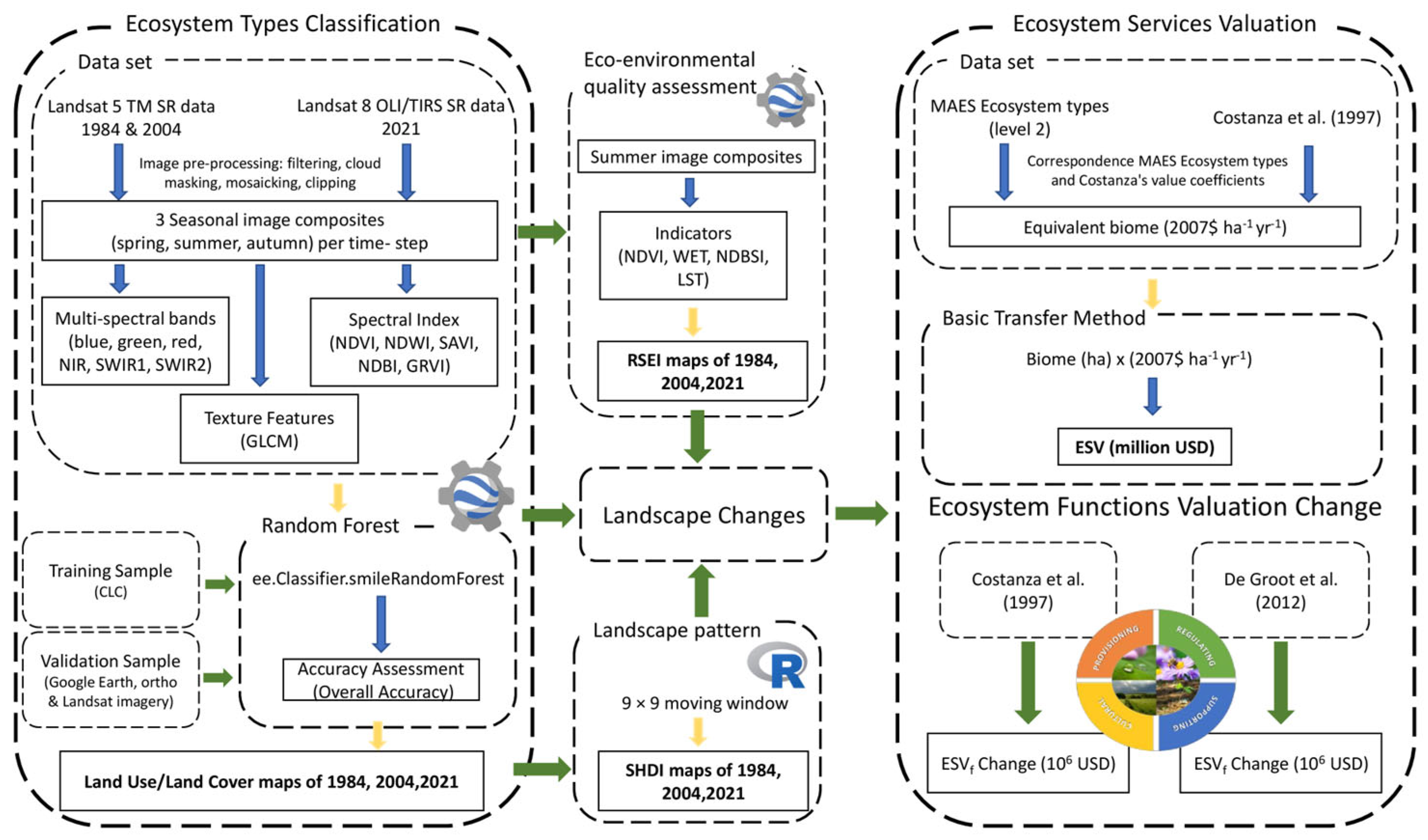

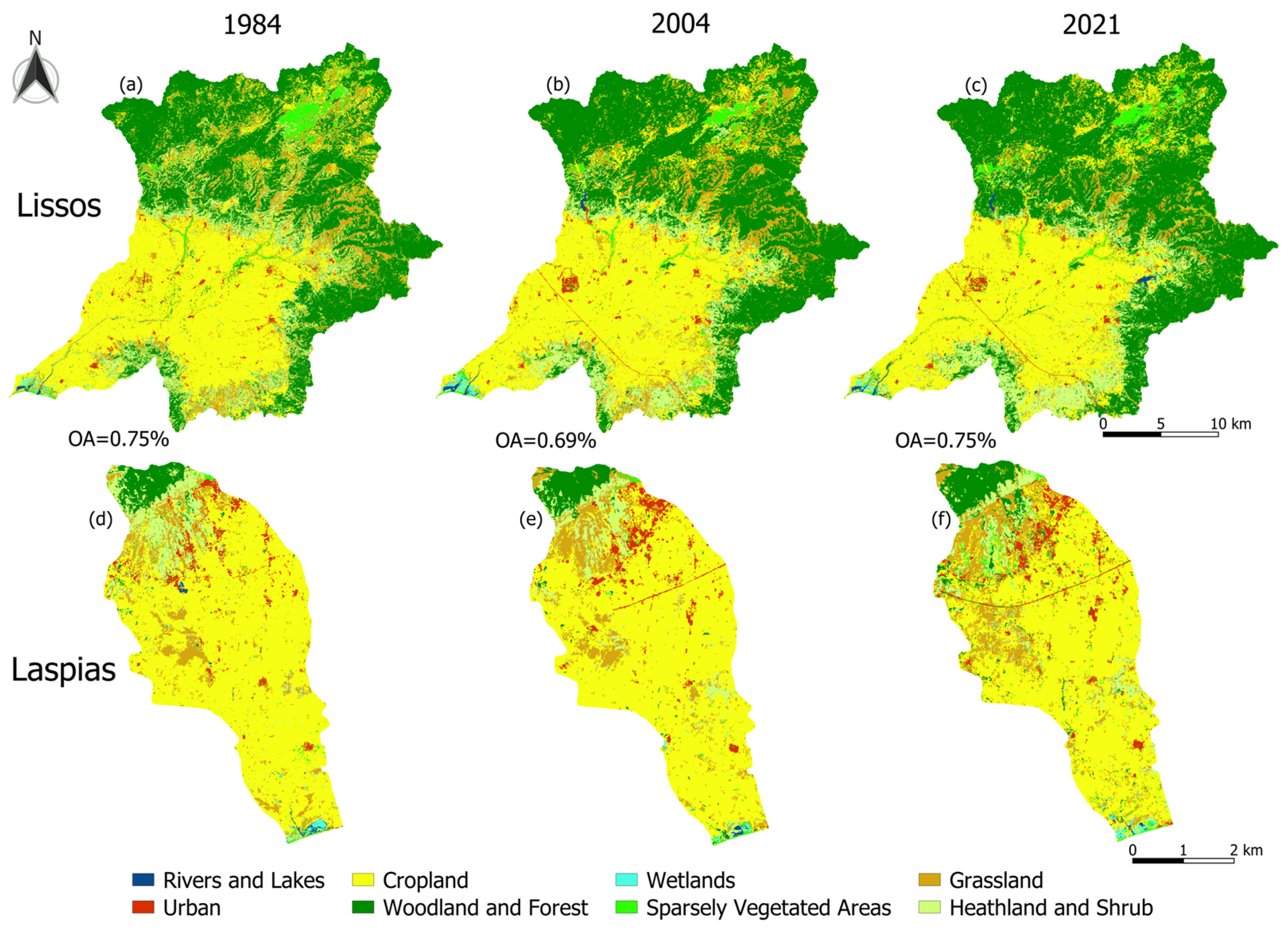

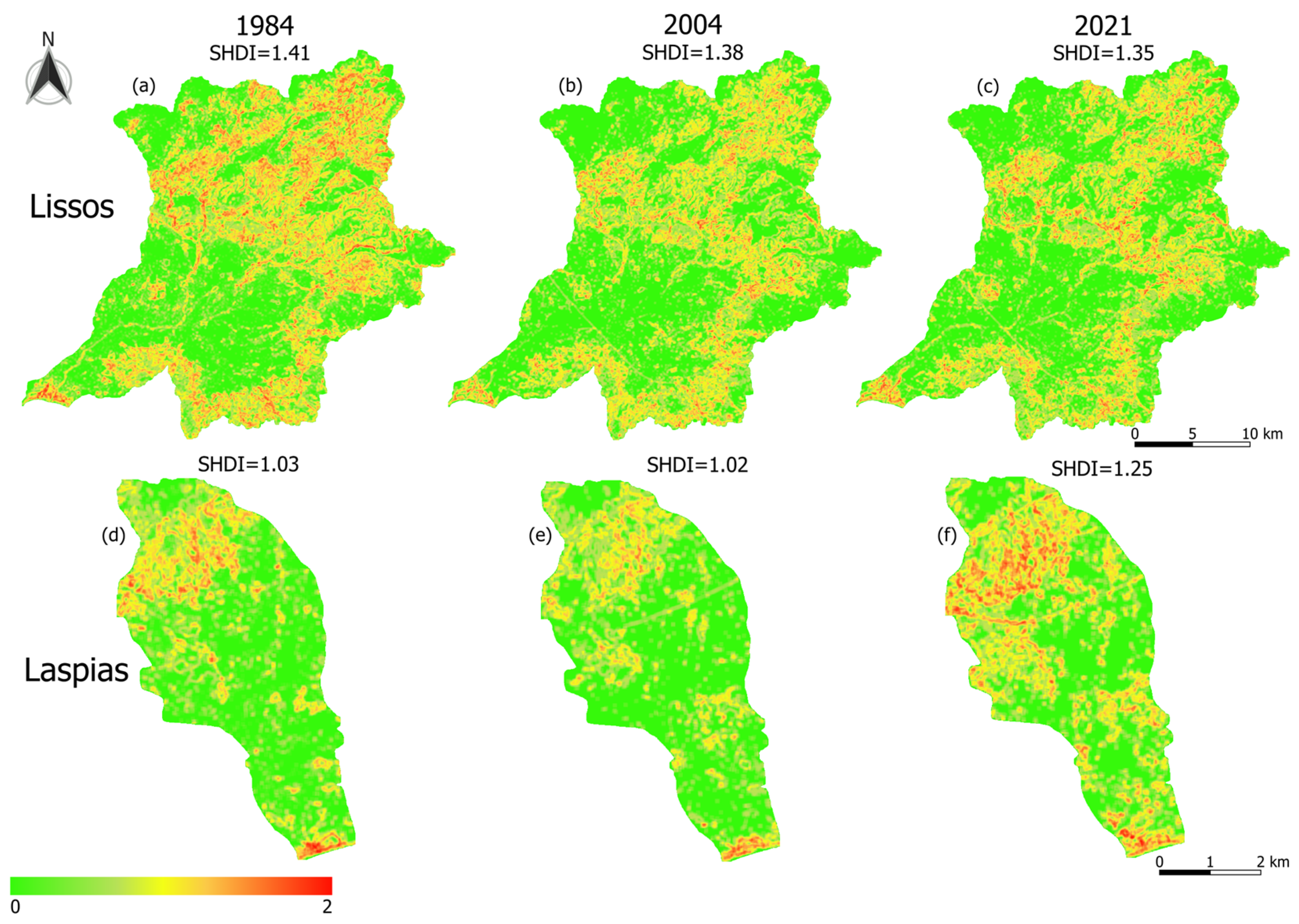



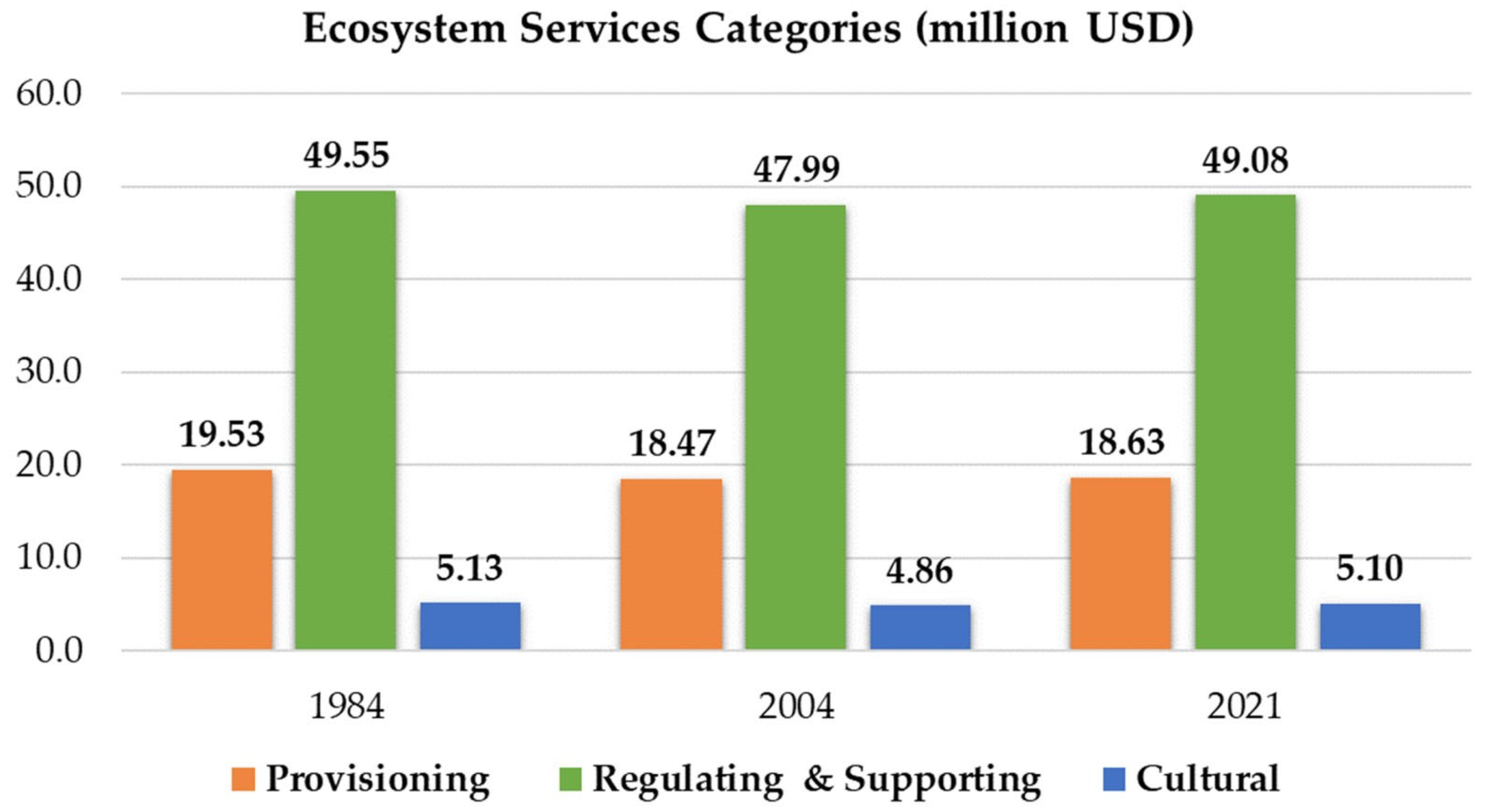

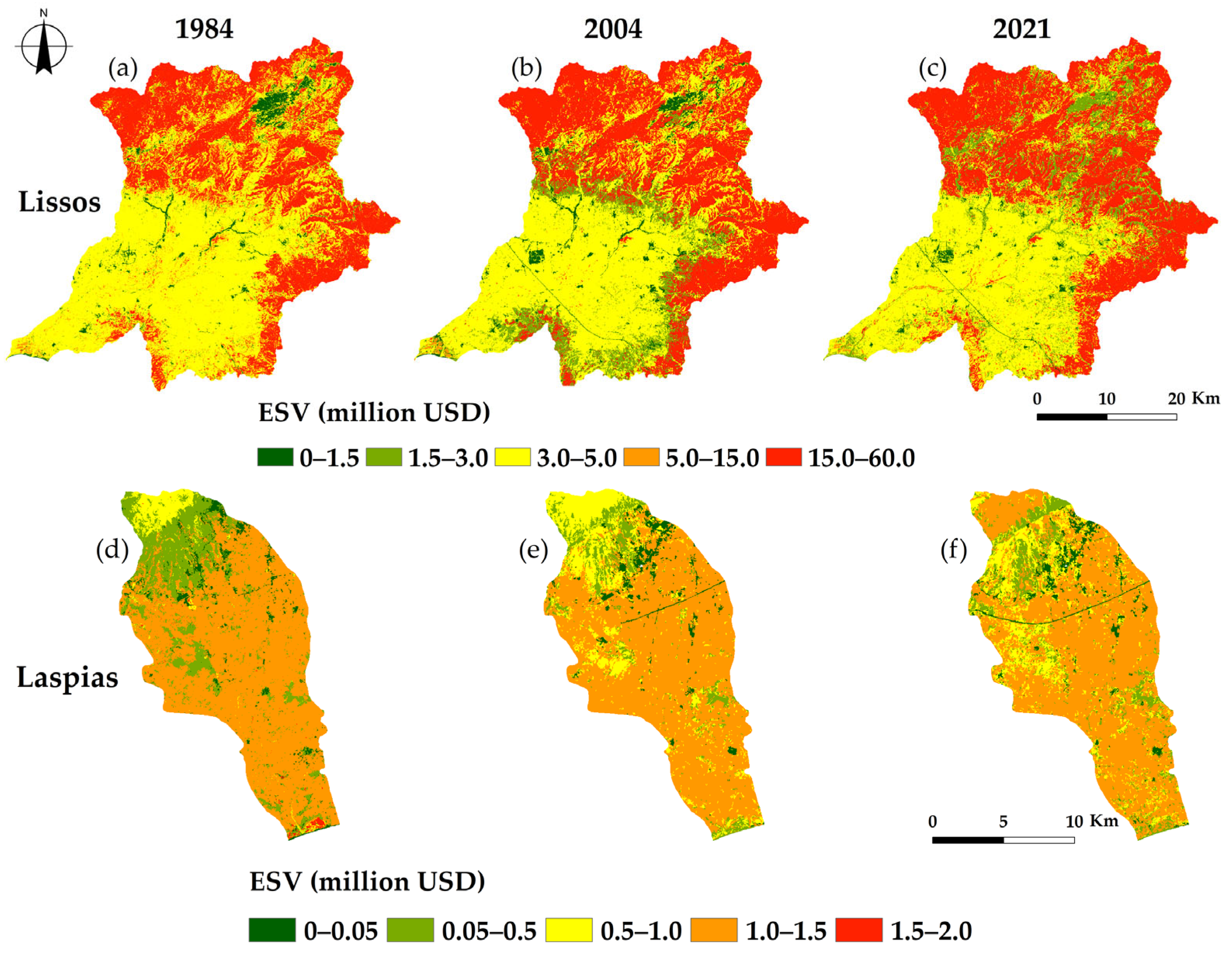
| Year | Season | Landsat 5 (TM) | Landsat 8 (OLI/TIRS) | Dataset |
|---|---|---|---|---|
| 1984 | Spring | 1986/03/01–1986/05/31 | - | LT05/C02/T1_L2 |
| Summer | 1984/06/01–1984/08/31 | - | ||
| Autumn | 1984/09/01–1984/11/30 | - | ||
| 2004 | Spring | 2005/01/01–2005/05/31 | LT05/C02/T1_L2 | |
| Summer | 2004/06/01–2004/08/31 | - | ||
| Autumn | 2004/09/01–2004/10/31 | - | ||
| 2021 | Spring | - | 2021/03/01–2021/05/31 | LT08/C02/T1_L2 |
| Summer | - | 2021/06/01–2021/08/31 | ||
| Autumn | - | 2021/09/01–2021/10/31 |
| Ecosystem Types Level 2 | CLC Level 2 | CLC Level 3 |
|---|---|---|
| Urban (Urb) | 1.1. Urban fabric | |
| 1.2. Industrial, commercial, and transport units | ||
| 1.3. Mine, dump, and construction sites | ||
| 1.4. Artificial non-agricultural vegetated areas | ||
| Cropland (Crop) | 2.1. Arable land | |
| 2.2. Permanent crops | ||
| 2.4. Heterogeneous agricultural areas | ||
| Grassland (Grass) | 2.3. Pastures | 3.2.1. Natural grassland |
| Woodland and Forest (W–F) | 3.1. Forests | 3.2.4. Transitional woodland and shrub |
| Heathland and Shrub (H–S) | 3.2. Shrub and/or herbaceous vegetation association | 3.2.2. Moors and heathland |
| 3.2.3. Sclerophyllous vegetation | ||
| Sparsely Vegetated Land (SVL) | 3.3. Open spaces with little or no vegetation | |
| Wetlands (Wet) | 4.1. Inland wetlands | |
| Rivers and Lakes (R–L) | 5.1. Inland waters |
| Spectral Index | Index Formula | Reference |
|---|---|---|
| Normalized Difference Vegetation Index (NDVI) | [28] | |
| Normalized Difference Water Index (NDWI) | [29] | |
| Soil-Adjusted Vegetation Index (SAVI) | [30] | |
| Normalized Difference Built-up Index (NDBI) | [31] | |
| Green–Red Vegetation Index (GRVI) | [28] |
| Indicators | Index Formula | Explanation | Reference |
|---|---|---|---|
| Normalized Difference Vegetation Index (NDVI) | NIR and RED represent Landsat 5 TM and Landsat 8 OLI/TIRS bands, respectively. | [28] | |
| Wetness (WET) | βi are parameters and BLUE, GREEN, RED, NIR, SWIR1, SWIR2 bands of Landsat 5 TM and Landsat 8 OLI/TIRS, respectively. | [39,40] | |
| Normalized Difference Built-Upand Soil Index (NDBSI) | SI and IBI represent Soil Index and Building Index, respectively. | [41] | |
| Land Surface Temperature (LST) | λ is the central wave length of the thermal band of Landsat 5 TM and Landsat 8 OLI/TIRS, ρ = 1.438 × 10−2 mK, ε is the land surface. | [38] |
| MAES Ecosystem Types (Level 2) | Equivalent Biome | Value Coefficient (2007 $ ha−1 yr−1) |
|---|---|---|
| Urban (Urb) | Urban | 6661 |
| Cropland (Crop) | Cropland | 5567 |
| Grassland (Grass) | Grass/Rangelands | 4166 |
| Woodland and forest (W–F) | Forest | 3800 |
| Heathland and shrub (H–S) | Grass/Rangelands | 4166 |
| Sparsely vegetated land (SVL) | Temperate/Boreal | 3137 |
| Wetlands (Wet) | Wetland | 140,174 |
| Rivers and lakes (R–L) | Lakes/rivers | 12,512 |
| Lissos | Laspias | |||||
|---|---|---|---|---|---|---|
| RSEI Level | 1984 | 2004 | 2021 | 1984 | 2004 | 2021 |
| Poor (0–0.2) | 4.55 | 6.15 | 1.91 | 2.92 | 9.27 | 0.21 |
| Fair (0.2–0.4) | 37.53 | 33.26 | 33.15 | 57.33 | 41.69 | 28.36 |
| Moderate (0.4–0.6) | 30.08 | 30.67 | 31.60 | 27.05 | 33.91 | 51.63 |
| Good (0.6–0.8) | 21.23 | 23.27 | 26.86 | 11.35 | 13.58 | 16.48 |
| Excellent (0.8–1) | 6.62 | 6.66 | 6.49 | 1.34 | 1.55 | 3.31 |
| ESV (Million USD) | |||||||
|---|---|---|---|---|---|---|---|
| 1984–2004 | 2004–2021 | 1984–2021 | 1984–2021 | ||||
| Biomes | Area (ha) | Value | Area (ha) | Value | Area (ha) | Value | (%) |
| Urban | 304.47 | 2.03 | 248.04 | 1.65 | 552.51 | 3.68 | 32.7 |
| Cropland | −1998.54 | −11.13 | −1066.86 | −5.94 | −3065.40 | −17.07 | −5.6 |
| Grass/Rangelands | −1271.1 | −5.30 | −4433.94 | −18.47 | −5705.01 | −23.77 | −17.5 |
| Forest | 3574.35 | 13.58 | 3795.12 | 14.42 | 7369.47 | 28.00 | 13.5 |
| Temperate/Boreal | −220.86 | −0.69 | 1362.24 | 4.27 | 1141.38 | 3.58 | 28.1 |
| Wetlands | −330.57 | −46.34 | −38.61 | −5.41 | −369.18 | −51.75 | −49.5 |
| Lakes/Rivers | −58.32 | −0.73 | −61.34 | −0.77 | −119.66 | −1.50 | |
| Total | −48.57 | −10.24 | −58.81 | ||||
| ESV (Million USD) | |||||||
|---|---|---|---|---|---|---|---|
| 1984–2004 | 2004–2021 | 1984–2021 | 1984–2021 | ||||
| Biomes | Area (ha) | Value | Area (ha) | Value | Area (ha) | Value | (%) |
| Urban | 198.27 | 1.32 | 23.31 | 0.16 | 221.58 | 1.48 | 33.5 |
| Cropland | 10.62 | 0.06 | −2119.32 | −11.80 | −2108.70 | −11.74 | −14.0 |
| Grass/Rangelands | −156.33 | −0.65 | 1159.92 | 4.83 | 1003.59 | 4.18 | 24.1 |
| Forest | 47.43 | 0.18 | 496.35 | 1.89 | 543.78 | 2.07 | 57.2 |
| Temperate/Boreal | 14.85 | 0.05 | 419.13 | 1.31 | 433.98 | 1.36 | 302.9 |
| Wetlands | −78.03 | −10.94 | 44.46 | 6.23 | −33.57 | −4.71 | −25.2 |
| Lakes/Rivers | −39.60 | −0.50 | −22.59 | −0.28 | −62.19 | −0.78 | −79.0 |
| Total | −10.48 | 2.34 | −8.14 | ||||
| ESVf (Million USD) | Overall Change | |||||
|---|---|---|---|---|---|---|
| Ecosystem Services Categories | Ecosystem Functions | 1984 | 2004 | 2021 | Value | (%) |
| Provisioning | Food production | 7.88 | 7.74 | 7.61 | −0.27 | −3.47 |
| Raw materials | 7.74 | 8.19 | 8.74 | 1.01 | 13.01 | |
| Water supply | 3.91 | 2.54 | 2.28 | −1.63 | −41.80 | |
| Regulating and Supporting | Gas regulation | 0.33 | 0.27 | 0.24 | −0.09 | −27.24 |
| Climate regulation | 8.08 | 8.56 | 9.22 | 1.14 | 14.11 | |
| Disturbance regulation | 3.50 | 2.00 | 1.83 | −1.66 | −47.52 | |
| Water regulation | 2.56 | 2.24 | 1.90 | −0.66 | −25.76 | |
| Biological control | 2.18 | 2.11 | 1.99 | −0.19 | −8.51 | |
| Waste treatment | 11.35 | 10.11 | 9.97 | −1.38 | −12.14 | |
| Nutrient cycling | 19.76 | 21.05 | 22.42 | 2.66 | 13.46 | |
| Habitat/refugia | 0.23 | 0.13 | 0.11 | −0.11 | −49.49 | |
| Pollination | 1.57 | 1.51 | 1.39 | −0.19 | −11.78 | |
| Cultural | Recreation | 4.35 | 4.37 | 4.63 | 0.28 | 6.36 |
| Cultural | 0.77 | 0.49 | 0.47 | −0.31 | −39.78 | |
| Total | 74.21 | 71.33 | 72.80 | |||
| ESVf (Million USD) | Overall Change | |||||
|---|---|---|---|---|---|---|
| Ecosystem Services Categories | Ecosystem Functions | 1984 | 2004 | 2021 | Value | (%) |
| Provisioning | Food production | 1.18 | 1.15 | 1.17 | −0.01 | −1.08 |
| Raw materials | 0.15 | 0.15 | 0.23 | 0.08 | 55.34 | |
| Water supply | 0.68 | 0.30 | 0.42 | −0.26 | −38.14 | |
| Regulating and Supporting | Gas regulation | 0.05 | 0.04 | 0.05 | 0.00 | 5.47 |
| Climate regulation | 0.15 | 0.15 | 0.26 | 0.11 | 78.38 | |
| Disturbance regulation | 0.61 | 0.25 | 0.45 | −0.15 | −24.96 | |
| Water regulation | 0.45 | 0.23 | 0.11 | −0.34 | −75.26 | |
| Biological control | 0.46 | 0.46 | 0.44 | −0.02 | −5.37 | |
| Waste treatment | 1.07 | 0.71 | 1.06 | −0.01 | −0.86 | |
| Nutrient cycling | 0.34 | 0.36 | 0.54 | 0.20 | 57.25 | |
| Habitat/refugia | 0.04 | 0.02 | 0.03 | −0.01 | −25.22 | |
| Pollination | 0.31 | 0.31 | 0.31 | 0.00 | −1.41 | |
| Cultural | Recreation | 0.17 | 0.12 | 0.19 | 0.02 | 11.69 |
| Cultural | 0.12 | 0.05 | 0.09 | −0.03 | −23.12 | |
| Total | 5.76 | 4.28 | 5.34 | |||
| ESV (Million USD) | Coefficient of Sensitivity | ||||||
|---|---|---|---|---|---|---|---|
| Equivalent Biome | Adjustment | 1984 | 2004 | 2021 | 1984 | 2004 | 2021 |
| Urban | VC + 50% | 6.61 | 8.59 | 8.83 | 0.034 | 0.048 | 0.049 |
| VC − 50% | 2.20 | 2.86 | 2.94 | ||||
| Cropland | VC + 50% | 125.81 | 125.90 | 108.20 | 0.649 | 0.706 | 0.595 |
| VC − 50% | 41.94 | 41.97 | 36.07 | ||||
| Grass/Rangelands | VC + 50% | 26.01 | 25.04 | 32.28 | 0.138 | 0.145 | 0.193 |
| VC − 50% | 8.67 | 8.35 | 10.76 | ||||
| Forest | VC + 50% | 5.41 | 5.68 | 8.51 | 0.028 | 0.032 | 0.047 |
| VC − 50% | 1.80 | 1.89 | 2.84 | ||||
| Temperate/Boreal | VC + 50% | 0.67 | 0.74 | 2.72 | 0.003 | 0.004 | 0.015 |
| VC − 50% | 0.22 | 0.25 | 0.91 | ||||
| Wetlands | VC + 50% | 27.99 | 11.58 | 20.93 | 0.144 | 0.065 | 0.115 |
| VC − 50% | 9.33 | 3.86 | 6.98 | ||||
| Lakes/Rivers | VC + 50% | 1.48 | 0.73 | 0.31 | 0.008 | 0.004 | 0.002 |
| VC − 50% | 0.49 | 0.24 | 0.10 | ||||
| ESV (Million USD) | Coefficient of Sensitivity | ||||||
|---|---|---|---|---|---|---|---|
| Equivalent Biome | Adjustment | 1984 | 2004 | 2021 | 1984 | 2004 | 2021 |
| Urban | VC + 50% | 16.89 | 19.94 | 22.41 | 0.014 | 0.018 | 0.021 |
| VC − 50% | 5.63 | 6.65 | 7.47 | ||||
| Cropland | VC + 50% | 454.32 | 437.63 | 428.72 | 0.388 | 0.399 | 0.396 |
| VC − 50% | 151.44 | 145.88 | 142.91 | ||||
| Grass/Rangelands | VC + 50% | 203.20 | 195.25 | 167.54 | 0.174 | 0.178 | 0.155 |
| VC − 50% | 67.73 | 65.08 | 55.85 | ||||
| Forest | VC + 50% | 312.07 | 332.44 | 354.07 | 0.267 | 0.303 | 0.327 |
| VC − 50% | 104.02 | 110.81 | 118.02 | ||||
| Temperate/Boreal | VC + 50% | 19.11 | 18.07 | 24.48 | 0.016 | 0.016 | 0.023 |
| VC − 50% | 6.37 | 6.02 | 8.16 | ||||
| Wetlands | VC + 50% | 156.86 | 87.35 | 79.23 | 0.134 | 0.080 | 0.073 |
| VC − 50% | 52.29 | 29.12 | 26.41 | ||||
| Lakes/Rivers | VC + 50% | 8.07 | 6.98 | 5.82 | 0.007 | 0.006 | 0.005 |
| VC − 50% | 2.69 | 2.33 | 1.94 | ||||
Disclaimer/Publisher’s Note: The statements, opinions and data contained in all publications are solely those of the individual author(s) and contributor(s) and not of MDPI and/or the editor(s). MDPI and/or the editor(s) disclaim responsibility for any injury to people or property resulting from any ideas, methods, instructions or products referred to in the content. |
© 2023 by the authors. Licensee MDPI, Basel, Switzerland. This article is an open access article distributed under the terms and conditions of the Creative Commons Attribution (CC BY) license (https://creativecommons.org/licenses/by/4.0/).
Share and Cite
Vatitsi, K.; Ioannidou, N.; Mirli, A.; Siachalou, S.; Kagalou, I.; Latinopoulos, D.; Mallinis, G. LULC Change Effects on Environmental Quality and Ecosystem Services Using EO Data in Two Rural River Basins in Thrace, Greece. Land 2023, 12, 1140. https://doi.org/10.3390/land12061140
Vatitsi K, Ioannidou N, Mirli A, Siachalou S, Kagalou I, Latinopoulos D, Mallinis G. LULC Change Effects on Environmental Quality and Ecosystem Services Using EO Data in Two Rural River Basins in Thrace, Greece. Land. 2023; 12(6):1140. https://doi.org/10.3390/land12061140
Chicago/Turabian StyleVatitsi, Katerina, Nena Ioannidou, Anastasia Mirli, Sofia Siachalou, Ifigenia Kagalou, Dionissis Latinopoulos, and Giorgos Mallinis. 2023. "LULC Change Effects on Environmental Quality and Ecosystem Services Using EO Data in Two Rural River Basins in Thrace, Greece" Land 12, no. 6: 1140. https://doi.org/10.3390/land12061140
APA StyleVatitsi, K., Ioannidou, N., Mirli, A., Siachalou, S., Kagalou, I., Latinopoulos, D., & Mallinis, G. (2023). LULC Change Effects on Environmental Quality and Ecosystem Services Using EO Data in Two Rural River Basins in Thrace, Greece. Land, 12(6), 1140. https://doi.org/10.3390/land12061140









